
Picture this: you’ve attracted shoppers to your online store, they’ve filled their carts, and just before completing the purchase—poof! They disappear. This frustrating scenario is called cart abandonment, a major hurdle in eCommerce. To boost sales, mastering the checkout process is key. Let’s explore the reasons and understand some proven strategies for streamlining your checkout and turning hesitant shoppers into loyal customers.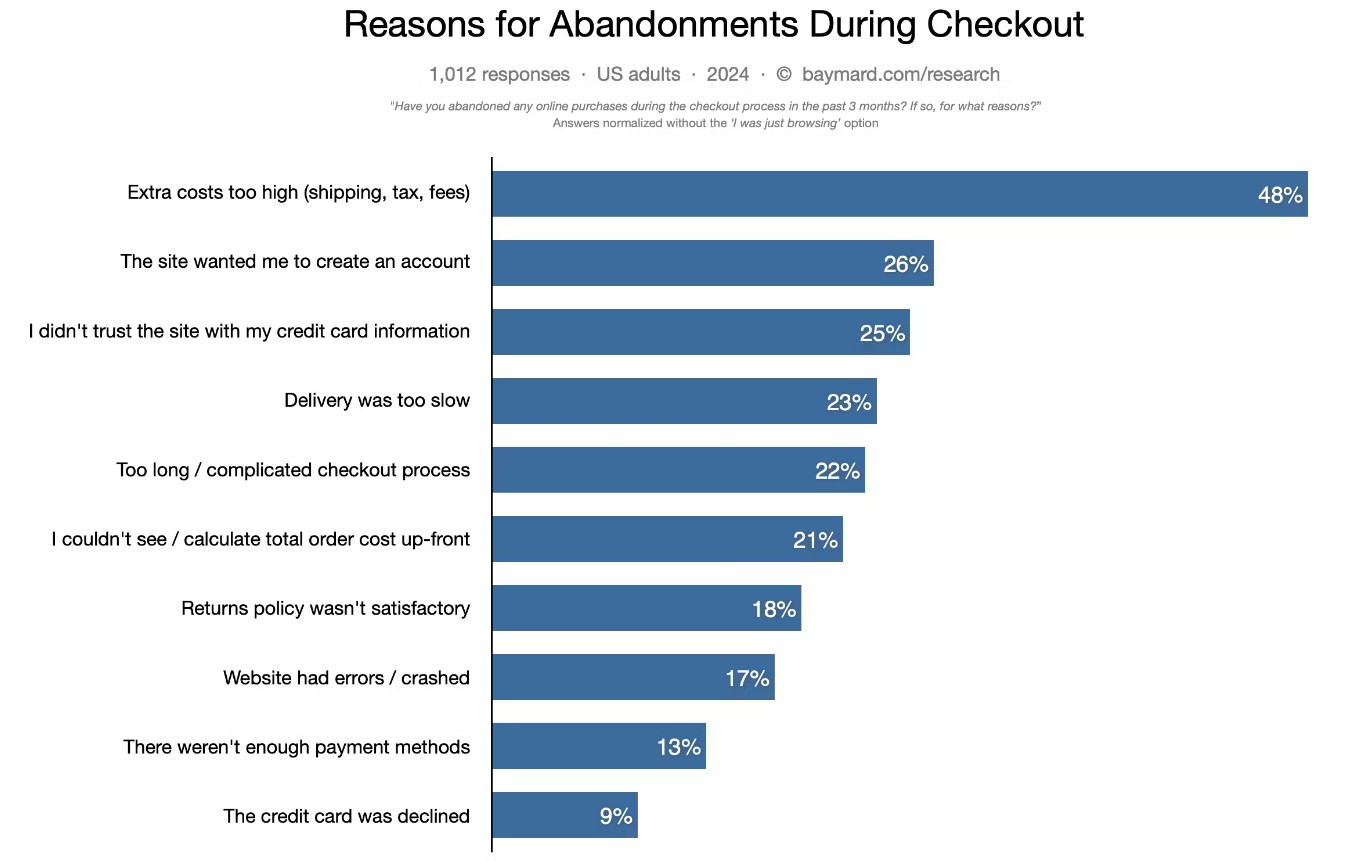
Image Source: Baymard
What is Shopping Cart Abandonment?
In simple terms, shopping cart abandonment occurs when a customer initiates the checkout process but leaves without completing the purchase. This directly impacts sales and revenue, making it vital for online businesses to understand and address this issue. According to Business Insider, it is believed that retailers have lost around $4.6 trillion to shopping cart abandonment.
How to Calculate the Shopping Cart Abandonment Rate?
Calculating your cart abandonment rate is straightforward and doesn’t require complex math. Here’s a simple method:
1. Find Your Cart Conversion Rate:

-
- This is the number of completed purchases divided by the number of shopping carts opened.
- For example, if your business recorded 100 completed purchases and 800 shopping carts opened in a month, the cart conversion rate would be (Completed purchases) divided by (Shopping carts opened).
2. Calculate the Cart Abandonment Rate:

- Subtract the cart conversion rate from 100% using the example above:
- The cart abandonment rate is simply 1 – the cart conversion rate
So, if your cart conversion rate is 12.5%, your cart abandonment rate would be 87.5%.
Shopping Cart Abandonment Statistics:

According to Statista, 2023, people frequently left their online shopping carts without buying anything from 2006 to 2024. The rate was 59.8% in 2006 and generally increased, peaking at 71.98% in 2012. After a small drop to 68.07% in 2014, the rate stayed around 70% from 2017 to 2024. This means many online shoppers often don’t finish their purchases. The cart abandonment rate of various industries in 2023 is mentioned below.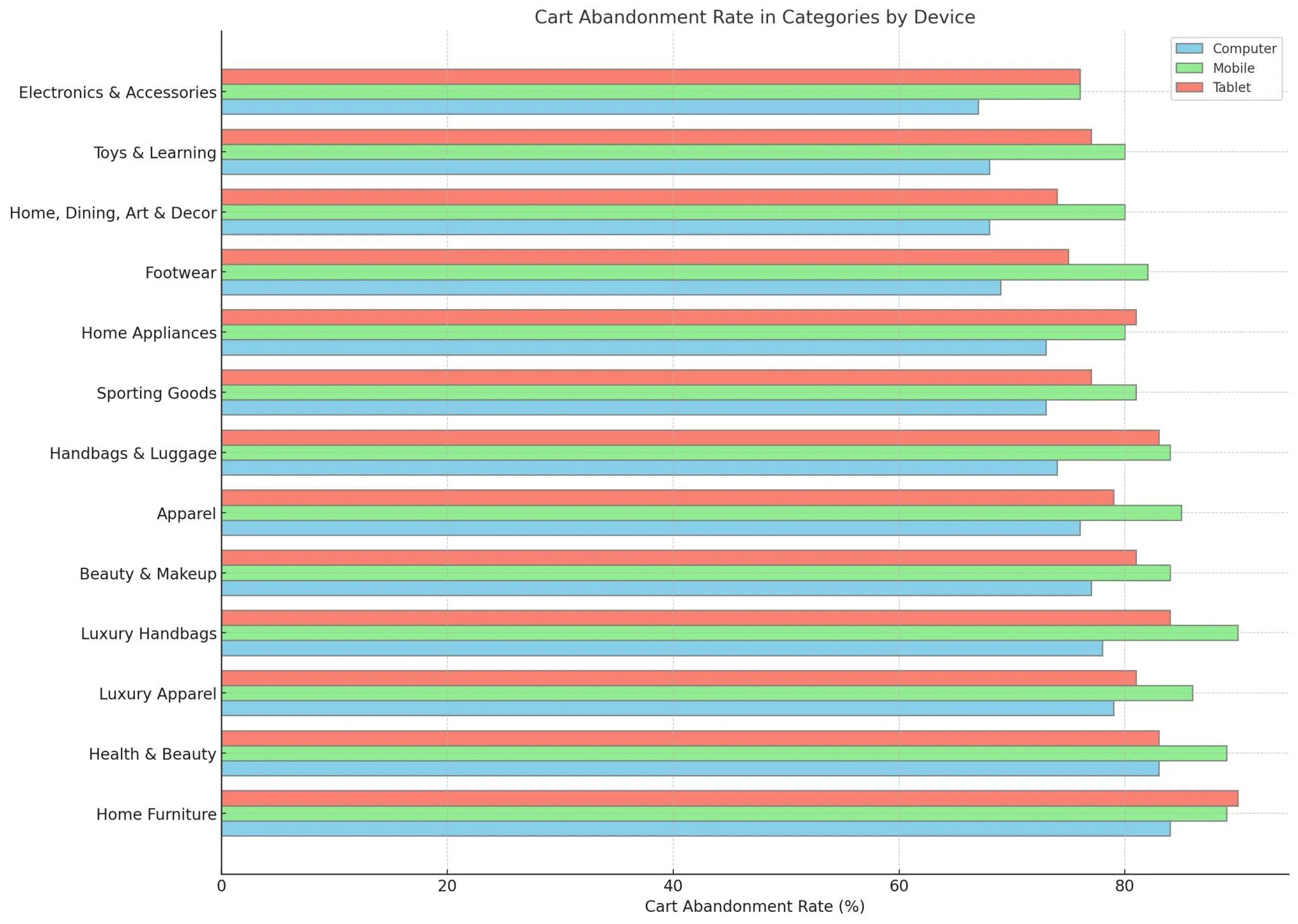
Image Source: Analyzify
Cart Abandonment Rate In Different Categories
| Category | Abandonment Rate |
| Home Furniture | 89% |
| Health and Beauty | 89% |
| Luxury Apparel | 86% |
| Luxury Handbags | 90% |
| Beauty and Makeup | 84% |
| Apparel | 85% |
| Handbags and Luggage | 84% |
| Sporting Goods | 81% |
| Home Appliances | 80% |
| Footwear | 82% |
| Home, Dining, Art, and Decor | 80% |
| Toys and Learning | 80% |
| Electronics and Accessories | 76% |
The rate of shopping cart abandonment also depends majorly on devices because if we check the shopping cart abandonment rate of mobiles, desktops, and tablets then we can see that the rate is comparatively higher in mobiles. Below is the average shopping cart abandonment rate in different devices like mobile, tablets, and computers.
Image Source: Analyzify
- Computers: 74.54%
- Mobile devices: 83.54%
- Tablets: 80.08%
Top Reasons Why Customers Abandon Carts + Solutions
1. Poor Design
The shopping experience on desktops and mobile phones can be very different. A lot of websites mainly design websites keeping in mind the desktop version and they do not optimize the mobile version. This is one of the major reasons behind the shopping cart abandonment rate.
This is how you can improve your add-to-cart checkout rate:
- Ensure your website adapts seamlessly to different screen sizes both mobile and desktop.
- Have a clear and prominent call-to-action buttons for adding items to the cart.
2. Slow Loading Speed
If the page speed is less then it not only affects the current visit of the customers, but they will likely hesitate to visit your website in the future also. A speedy checkout process can immensely boost the user experience positively.
This is how you can improve your add-to-cart checkout rate:
- Reduce the number of elements (images, scripts, stylesheets) that need to be fetched from the server. Combine multiple files into one where possible, use CSS sprites for icons, and consider lazy loading for images that are not immediately visible on the screen.
- Compress and resize images to reduce their file size without compromising quality. Use modern image formats like WebP where supported, and specify image dimensions in the HTML to prevent layout shifts as images load.
3. Fewer Payment Options
This is an issue for both mobiles and desktops. If any shopping website does not provide a lot of payment options, then it can lose a lot of customers. Small Businesses offering multiple payment options at checkout increase transactions by 30%, as users prefer to pay via Credit cards, PayPal (Electronic payment) & Debit cards mostly so, this kind of payment methods should be there on your ecommerce store without fail.
This is how you can improve your add-to-cart checkout rate:
- Offer major credit/debit cards, digital wallets (like PayPal), and alternative methods.
- Display security badges, use SSL certificates, and assure customers of safe transactions. Clear policies on refunds and data protection build confidence and encourage completed purchases.
4. Creation of Account Before Purchase
Some merchants need customers to register before making a purchase. This makes some customers feel uncomfortable sharing their personal information and consequently opt-out.
This is how you can improve your add-to-cart checkout rate:
- Instead of giving them the trouble related to creating an account, just have a guest checkout option and close the deal.
- You can only take an Email ID to send transaction mail, bill, and order tracking details during the guest checkout process rather than all details.
5. High Shipping Costs
Many brands and companies charge unreasonable shipping costs for the things they sell. Customers who do not purchase multiple products or buy products in bulk will find this extremely expensive. In addition, today’s customers do not accept excessive shipping costs for products that are not delivered within a few days. As a result, customers are redirected to other websites in search of better deals or free shipping options. Nothing irritates customers more than hidden fees.
This is how you can improve your add-to-cart checkout rate:
- You can implement a free shipping limit where customers who reach a certain order value can avail free shipping.
- Try using local or regional carriers for strategic locations to minimize shipping costs.
6. Affordable Prices on Other Platforms
Consumers are notably research-driven in today’s era of online shopping. They search through several websites and compare costs before creating online purchases. Thus, better ratings on different sites can tend to distract shoppers from your store as they perpetually seek for an improved deal right up till the ultimate minute of their transaction.
This is how you can improve your add-to-cart checkout rate:
- Offer price matching guarantee directly on the checkout page to ensure customers that they are getting the beast deal.
- Put up a statement declaring customers that if they find the same item at a lower price then you will match it instilling trust and confidence within the buyer.
7. Complicated Checkout Process
The checkout process involves specific steps that a consumer must go through to complete a transaction. It is the place where the customer completes their product selection, confirms the delivery option and makes the payment to purchase the product. Therefore, a well-designed and simple checkout is required to reduce consumer abandonment.
This is how you can improve your add-to-cart checkout rate:
- Follow the principle of KISS (Keep It Simple and Short) for your eCommerce website checkout process.
- Keep the number of clicks to three, let a user choose a product, add it to the cart, and check it out, resulting in simpler, faster, and better conversions.
8. Lack of Customer Support
Another major cause of cart abandonment is a lack of effective consumer support. This not only distracts your current customers but also confuses new customers because many times, a customer will not receive sufficient assistance from the support personnel while looking through the merchandise.
This is how you can improve your add-to-cart checkout rate:
- Live chat support is easily accessible and e-commerce websites can interact in real-time with the customers to solve their issues and difficulties.
- Curate a detailed FAQ section and address common questions and queries about shipping, returns, product specifications, and contact details.
9. Didn’t Find the Coupon Code
Not being able to find the relevant Coupon code is also a leading cause of cart abandonment. When this code is not shown in the correct location, it wastes important time and upsets your consumers.
This is how you can improve your add-to-cart checkout rate:
- If you have any coupon code or discount for a particular product, showcase them in the checkout process.
- Include instructions near the coupon code box or provide a link to a dedicated page with current promotions and codes.
10. Window Shopping
Just as people often visit shops to window shop, online shoppers also follow the same pattern. Many times they add items to the cart not to purchase them immediately but rather to save or bookmark them for future purchases.
This is how you can improve your add-to-cart checkout rate:
- Present them with visual cues or urgency tactics tempting them to make a purchase.
- Give them different options like saving items to a cart, adding products to their Wishlist or even sharing them with their friends and family.
11. Web Rooming
This fascinating term Web Rooming is also known as ‘research online, buy offline’. Here customers visit online websites to research products before making purchases at their nearby offline stores.
This is how you can improve your add-to-cart checkout rate:
- Provide discounts or promotions for completing purchases online. Highlight the benefits of online purchases such as home delivery or versatile product selection.
- Include detailed product information, customer reviews, and high-quality images to enhance the online shopping experience and tempt customers to purchase the product.
12. Unexpected Costs at the Checkout Process
Sometimes customers abandon their carts because of unexpected costs that appear during the check-out process. These costs include shipping fees, taxes, or hidden charges not mentioned previously.
This is how you can improve your add-to-cart checkout rate:
- Mention and display all these costs in the product page to keep things transparent.
- To calculate estimated shipping costs, provide customers with a shipping calculator or an estimator.
13. Impulse Buying
Sometimes, people add impulsively products in their carts only to realize that they do not need them or might want to purchase them later. Budget and changing preferences can impact the buyers here.
This is how you can improve your add-to-cart checkout rate:
- Place a Facebook tracking pixel or Google Remarketing Tag on your site which will capture the behavior of a visitor. Craft a Facebook ad campaign or Google Dynamic Remarketing Ads that target those users who left your website without making any purchase.
- Create ads based on the products they viewed, and tempt them into making a purchase. Here is the list of audiences for whom ecommerce store can set up remarketing ads and grab sales from abandon cart users.
Audience 1 – Visited cart page but didn’t make any purchase (Average chances for sales)
Audience 2 – Visited Checkout page but didn’t make any purchase (Higher chances for sales)
14. Mismatched Messaging
When consumers click on an ad, they expect the landing page to match what was promised. If the landing page doesn’t deliver on those expectations—like if the messaging doesn’t align with the ad—it causes confusion and makes customers doubt the credibility. This can lead them to hesitate or leave without making a purchase.
This is how you can improve your add-to-cart checkout rate:
- Keep your ad and landing page messaging similar to meet customer expectations accurately.
- Regularly review and update campaigns to reflect current promotions and product availability, reducing confusion and improving conversion rates.
15. Unclear CTAs
When CTAs are uncertain or unclear, the user is left confused about what action they need to perform hence abandoning the checkout process. Unclear CTAs include ‘Continue’ or ‘Submit’ that may come across as vague and not action-specific.
This is how you can improve your add-to-cart checkout rate:
- Display CTAs that are clear, action-oriented, and help the users to navigate the checkout process.
- You can use ‘Proceed to Payment’ or ‘Complete Purchase’ Buttons to help customers to checkout with ease.
16. Waiting for Sale
When customers wait for a sale before buying, they might end up abandoning their carts if the sale doesn’t happen or doesn’t meet their expectations. They could also find better deals elsewhere or lose interest in the items over time.
This is how you can improve your add-to-cart checkout rate:
- Create urgency by offering limited-time promotions or flash sales.
- Provide personalized discounts based on customer behavior or purchase history.
15 Actionable Tips to Reduce Cart Abandonment
1. Set Clear Product Quantity Limits

Image Source: Opencart
The e-commerce website should prominently display messages like “Few products left” for items nearing depletion in stock. This proactive communication alerts customers to limited availability, helping them make informed purchasing decisions before products run out. Such notifications can effectively manage customer expectations, reduce cart abandonment rates, and enhance overall shopping satisfaction by ensuring transparency about product availability.
2. Add Proper Information on the Cart Page
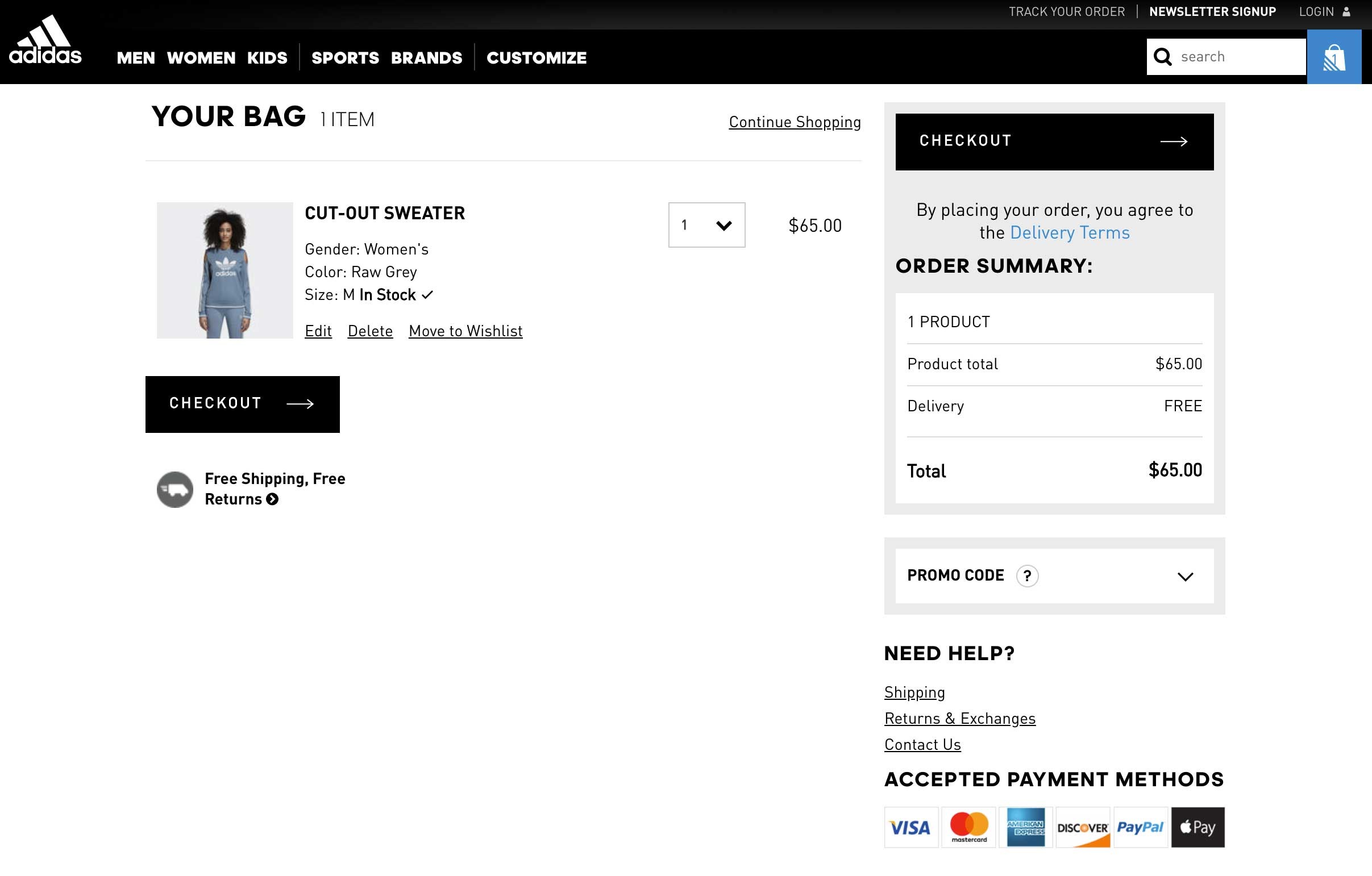
Image Source: AB Tasty
It should be easy to find the total price of any product and there should be no hidden costs like taxes. Thumbnails of the products should be clearly visible throughout the check-out process as it assures the customers about their product and purchase. There should be progress indicators on the check-out page because it allows users to know how much process is left to complete. Some of the other features that you can include in a shopping cart page are price & quantity, stock availability, payment options, etc.
3. Communicate a Clear Return & Refund Policy
Refund and return policies are very important for e-commerce because customers cannot try any product and that is why they want assurance that if anything is wrong with the product then they can easily return it and get a refund. A good return and refund policy motivates customers to buy any product without giving it a second thought.
4. Set Realistic Delivery Times

Image Source: Pinterest
Usually, customers want their products to be delivered over a certain period and if there is an unexpected delivery time then customers will look for the product on any other e-commerce platform. The unexpected delivery time can be a huge turn-off for customers, and it will increase the shopping cart abandonment rate.
5. Ensuring SSL Certification
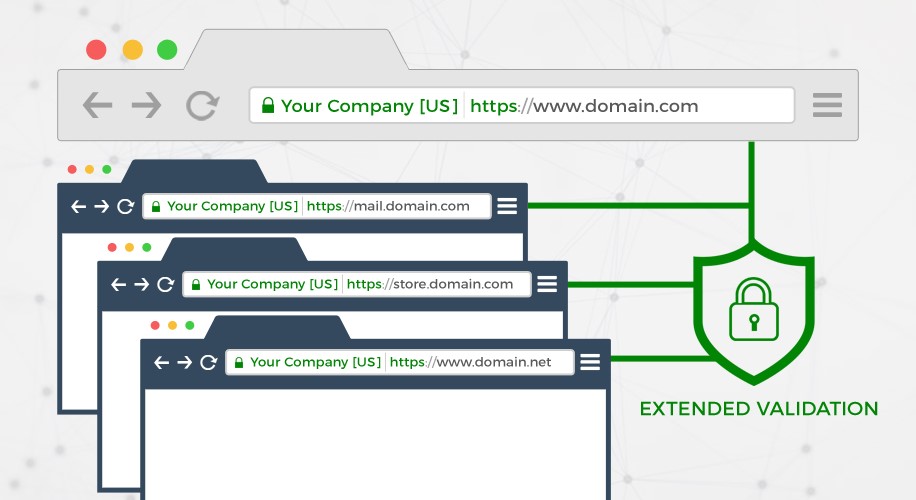
Image Source: Digifloor
When customers make a purchase, they put a lot of trust in the e-retailer. While making a purchase, they hand over their personal financial information to you, and with so many credit card breaches happening over the years, customers need to feel safe while transacting on your site. There are many shoppers who do not place orders at the last minute if they feel insecure while buying from an ecommerce website. The best way to eliminate this fear is by installing an SSL certificate and having secure site badges on your site. This will let the customers know that their connection is secure, which will eventually help in creating a trustworthy process. The importance of an SSL certificate for an eCommerce site is very high and every e-commerce store should install it. 30% of users have said that they have to re-enter the credit card information and that’s the main reason they abandon the cart – If your site has SSL certificate and other trusted badges then they trust if there was some issue in adding the credit card info on the checkout page.
6. Respond Quickly to Abandoned Carts
When a cart is abandoned, personal attention is crucial beyond automated responses. Respond promptly to abandonment notifications, offering assistance to address user concerns and pain points, such as coupon or payment errors, directly through a live chat option on the checkout page. Here’s how you can effectively re-engage users:
Note – We have seen and experienced quick outreach on travel booking sites or loan booking sites. As soon as you close the site without booking or inquiring anything they will call you within an hour and it works.
i. Send Follow Up E-mails After Cart Abandonment

Many a time users abandon the cart just before checkout. In that case, get their email ID. Use it as a source of communication and set an email drip to notify them of the left items in the cart. Follow up on those emails for 24 hours. If there is no response, keep them updated about the latest discounts and coupon codes to trigger a call to action and completion of the process.
Note: Don’t spam their inbox by sending emails again and again.
ii. Send Follow Up WhatsApp Message After Cart Abandonment

Sending follow-up WhatsApp messages after cart abandonment is a powerful strategy to re-engage customers effectively. Personalize your messages by addressing the abandoned items, use clear calls-to-action to prompt action, and consider including incentives like discounts or special offers to encourage completion of their purchase. Timing is crucial; send messages shortly after abandonment to maintain interest.
7. Offer Coupon Codes / Free Shipping/ Promotion Details

Image Source: Sheetlabels
On your website’s cart page, highlight what extra you have to offer. Customers love new offers, coupon codes, and discounts. Thus if you have any coupon code or discount for a particular product, showcase them in the checkout process. Moreover, if you keep the shipping free, it will bring a lot of smiles. Show the customers that they can get a great deal if they complete the checkout process. There are plenty of Ecommerce promotion ideas that can be applied to your store including
- Free Shipping
- Percentage based discounts
- BOGO (Buy 1 Get 1 Free)
- Quantity Discounts
8. Minimize Distractions on the Checkout Page
The attention span of a person has drastically reduced to a mere eight seconds, so it is very important that you keep your website clean. Do not add too many banners or showcase too many ads. Cut off the unnecessary product.
9. Add Trust Signals
One of the best factors that promote a sense of belonging among consumers to buy from an unknown source and make payment is trust. Furthermore, if customers do not feel secure when purchasing on your website, your conversions will suffer.
- Add customer reviews, text, and video testimonials
- Add social proof to your checkout page
- Include contact information


10. Use Exit Pop-ups to Offer Incentives

Image Source: Retainful
Offer incentives with exit popups are some of the most lucrative thing that holds your consumers from going anywhere else. In fact, it is one of the primary reasons why customers return to your website.
11. Use Analytics to Monitor Abandonment
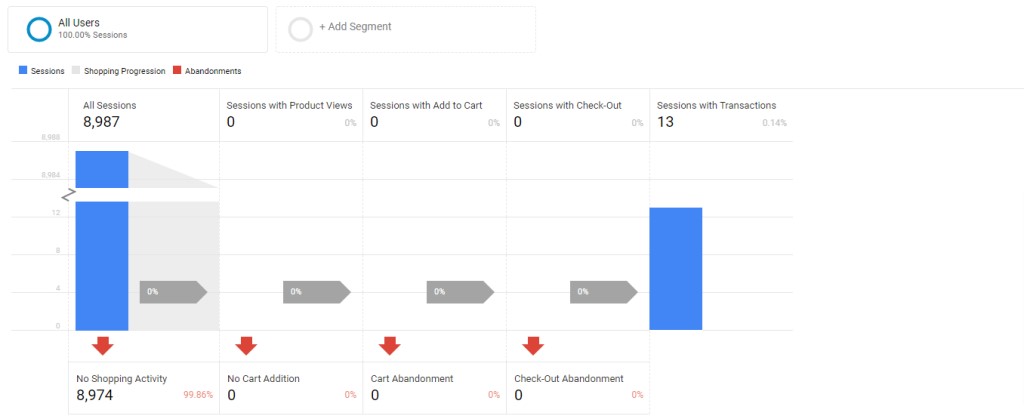
Today the market is loaded with numerous tools like Google Analytics and other technologies by which Retailers can measure desertion rates and spot patterns or changes in customer behavior. Further, this can assist merchants in identifying issues that may be affecting cart abandonment rates and finding solutions that enhance checkout conversion. So, you will have a concise idea about the shopping cart abandonment rate on your site by visiting Conversions – Goals – Funnel Visualization data in Google Analytics.
12. Reminding Returning Visitors
Use cookies or session storage to remember items left in the cart. When customers return to your site, gently remind them about their abandoned cart with a pop-up or a notification bar to encourage them to complete their purchase. Show discounts, free shipping, or limited-time offers to add urgency to the mind of the customer. Ensure these reminders are mobile-optimized and feature clear, prominent calls-to-action that lead directly back to the checkout process.
13. Offer Coins or Discounts at Checkout
Try introducing a loyalty program where customers can earn coins or points for their purchases. Allow them to use these coins for future purchases, incentivizing them to complete their checkout process. Encourage existing customers to refer family and friends by offering bonus points or coins for successful referrals. Display a clear policy on points expiry to create a sense of urgency and encourage customers to redeem their points sooner rather than later.
14. Use AR – Virtual Try to See the Real-Time Size and How It Looks
Implement Augmented Reality (AR) features to allow customers to virtually try on products. This can help them see the real-time size and appearance of items, reducing uncertainty and encouraging them to complete their purchase. Provide options for customers to customize their virtual try-on experience, such as adjusting colors, sizes, or styles directly within the AR interface. Offer tutorials or guides on how to use the AR feature effectively, helping customers maximize the benefits of virtual try-ons.
15. Display Cross-Selling Opportunities
Cross-selling opportunities include suggesting additional or related products to customers when added to the Wishlist or during the checkout process. This enhances the shopping experience and increases order value. However, if not done correctly, it can lead to distractions and even cart abandonment. Here’s how you can do it properly. You can use customer data and browsing behavior to suggest personalized cross-selling recommendations. Along with that showcasing bundle discounts or package details on the checkout page will help customers save money.
Image Source: Omnisend
Conclusion
These are some high-priority steps to optimize the checkout process to grab sales from users who abandon the cart. Reach out to those users via Email, Ad platforms, social media, and every possible way so, they come back to your store and buy that thing. Just one thing – Don’t spam their news feed, timeline, mail box by showing the ad again and again else they will mark it as spam and may not come to your store again in the future.

Contact Form Popup
Boost Your Business Now
This will close in 0 seconds
